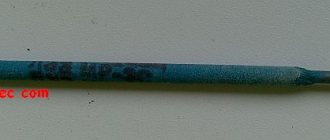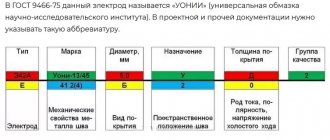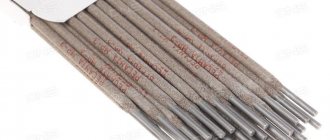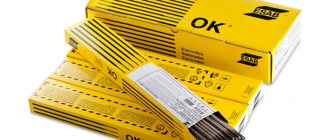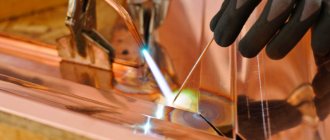Rutile electrodes: what are they and what are they for?
All electrodes are made according to the same principle: a special coating is applied to a metal rod made of a special alloy. As a rule, the type of coating determines where the electrodes of this type will be used.
Rutile coated electrodes are designed for manual arc welding.
The coating is made primarily from titanium dioxide. This allows you to achieve high quality welding seams and also has a beneficial effect on the entire welding process. REFERENCE: This type of coating is one of the safest, as it does not emit harmful substances during combustion that can be inhaled by the welder.
Why so popular
Rutile electrodes are considered one of the best. They have a number of advantages, thanks to which a welder with any experience can obtain an even and high-quality seam.
- Can be used with both AC and DC current . The welding arc in any case maintains combustion stability.
- You can weld metal joints coated with a light layer of primer .
- Ideal for use when welding short seams or in awkward places. The arc is easy to ignite and just as easy to re .
- Allows you to form a seam with a high impact strength . This is achieved due to the increased alkalinity of the slag.
- The rutile welded seam has excellent durability and fatigue strength . Even under prolonged exposure to alternating loads, it retains its qualities.
- a low spatter coefficient is characteristic . This makes the welding process more convenient for the welder.
- Convenient to reuse the electrode. After welding is completed, carbon residue remains on the tip of the rod, which does not need to be cleaned off (unlike other types of coatings). The carbon deposits of rutile electrodes are a semiconductor, so you can continue working without additional problems.
- Less harm to health . During the combustion of rutile coating, no hazardous substances are released. Therefore, there is less negative impact on the welder’s respiratory system.
IMPORTANT: Low requirements for the hob. Even with strong surface moisture, the seam does not lose its properties. Welding is also allowed in the presence of a corrosion layer (up to 30%).
Types of materials without weaving
Nonwovens include those in the manufacture of which fibers are not intertwined. They serve as insulation materials or as a basis for sewing clothes and shoes. Nonwoven materials are produced from both natural fibers and chemically treated ones. Secondary raw materials are also suitable for their creation - recycled clothing and scraps.
Tyvek, on the other hand, is very thin. The procedure for its manufacture is complex and time-consuming, but the final properties are worth it. It belongs to new fabrics, but is already widespread in the industrial area. Tyvek can be different - one of its representatives protects from moisture, the other from chemical influences. But all of them are distinguished by a thin, almost weightless structure with maximum protective properties.
Rutile electrode coating - characteristics
Electrodes with this type of coating can most often be of two main types: E42 and E46 (according to the state standard). The type must be indicated on the packaging label. Weld metal welded with E42 type electrodes has the following technical characteristics:
- Tensile strength - 410 MPa;
- Relative elongation - 22%;
- Impact strength - 80 J/cm2.
A seam welded with E46 electrodes has more durable characteristics:
- Tensile strength - 450 MPa;
- Relative elongation - 20%;
- Impact strength - 147 J/cm2.
In the manufacture of rutile electrodes, low-carbon welding wire (SV-08 or SV-08A) is used. A rutile coating is applied to it. The marking of such electrodes contains the letter “P”, which indicates the type of coating. As a rule, the letter “P” is always followed by two numbers:
- The first indicates in what spatial positions welding can be performed. Most rutile electrodes can be welded in any position.
- The second indicates the type of welding current: alternating or direct, its polarity and open circuit voltage.
Marking
Depending on the manufacturer and the specific type of product, package markings may differ slightly. However, most rutile electrodes are labeled almost the same. Let's take a closer look at the example of marking MP-3 electrodes.
On their packaging you can see the following markings: E 46 – MR-3 – UD E 430 (3) - P26.
Let's look at everything in order:
- E46 - indicates the type according to GOST. This means that this model is designed for welding low-alloy and carbon steels. Tensile strength - 46 kgf/mm2.
- MP-3 is a brand from the manufacturer.
- U - indicates the purpose of the electrode. For welding carbon steels, tensile strength is 60 kgf/mm2.
- D is the coating thickness coefficient (thick).
- E - international marking. Indicates the type of electrode with a consumable coating.
- 43 - tensile strength (430 MPa).
- 0—relative elongation index (20%).
- (3) - temperature indicator -20°C. This is the minimum temperature at which the weld metal retains an impact strength of at least 34 J/cm2.
- P - type of coating. In our case - rutile.
- 2 - shows in what positions welding work can be carried out. This indicator means that you can cook in any direction except vertical “top to bottom”.
- 6 - for high-quality work you need to use a current of reverse polarity, constant. The open circuit voltage should be approximately 70V.
[ads-pc-2][ads-mob-2]
Utility equipment and personal protective equipment
Hair and wire brushes, rags, containers for carrying and stirring bulk materials and garbage collection, brooms, stationery, gloves, goggles, respirators, etc.
All these little things add up to a hefty penny and cannot always be fully taken into account at the stage of drawing up a work estimate. Therefore, to simplify calculations, construction consumables are often allocated 3% of the cost of basic resources and included in the estimate as a general line without deciphering the nomenclature.
Physico-chemical composition
Depending on the manufacturers and various modifications, the composition of the rutile coating may differ slightly. However, in most cases the composition is as follows:
- Rutile concentrate (titanium dioxide) - 48%.
- Feldspar - 20%.
- Ferromanganese - 15%.
- Magnesite - 15%.
- Dextrin - 2%.
Some types of electrodes may also contain additional elements: for example, cellulose. Such coatings are marked with the letters “RC”, which stands for “rutile-cellulose coating”.
Rutile electrodes: application
Due to its excellent qualities, rutile coatings are widely used in various conditions and are considered one of the most practical types. We list the main applications in which electrodes of this type do an excellent job:
- Welding of low carbon steel structures . The chemical composition of the coating allows you to effectively work with ferrous and low-alloy metals. In such cases, the seam is smooth and without cracks.
Welding of pipelines. Excellent for repairing pipes that carry liquids. In this case, it is difficult to completely dry the working surface of the metal. However, the welding arc of rutile electrodes burns stably even when drops of water enter the combustion zone.- Widely used for repairing parts or tools that wear out over time . Rutile electrodes make it possible to deposit welds of considerable thickness as efficiently as possible. Due to small splashing, material savings are achieved.
Rutile coated electrodes: pros and cons
Compared to other types of coatings, rutile has a number of advantages:
- Seam durability . Welded metal is not susceptible to cold or hot cracks.
- In contrast to the acid coating, the rutile welding arc burns with alternating current as intensely as with direct current.
- Easy to process areas where short seams are needed . If the main coating requires continuous welding, since the welding arc is difficult to re-ignite, then with rutile it is easier. The arc ignites easily, and there is no need to clean carbon deposits from the tip of the rod.
- It is not necessary to prepare the work surface . Other types of electrodes are susceptible to oxidation and rust, resulting in a weak weld. Rutile electrodes allow you to form a stable and durable seam, regardless of the quality of the surface.
- After welding, the slag is easily separated , and the surface of the weld practically does not require grinding.
There are also disadvantages:
- Not suitable for all designs. The small range of metals with which this type of coating can be used imposes certain restrictions on their operation. Such electrodes cannot be used for welding high-carbon steel .
- The properties deteriorate sharply with increasing voltage. Therefore, you will have to monitor compliance with the nominal indicator.
- It is necessary to carry out preparatory work - drying and calcination .
[ads-pc-4][ads-mob-4]
Spare parts, abrasive and cutting tools
Each electric tool used in construction or repair requires its own equipment, which is a processing structural element, usually of a replaceable type. This includes drills, cutting wheels, grinding wheels, as well as lubricants and much more.
Consumables for construction tools are a significant cost element and the cause of endless disputes between the customer and the contractor. This situation is associated with a high degree of standardization of such components. With the same functionality, both the price and quality of products can have a serious difference. The choice is not always obvious, but if there is a large volume of work, it is worth giving preference to products from well-established manufacturers.
Construction equipment consumables can be classified according to the following criteria:
- Metalworking. These include drills, borings, metal cutters, cutting and sharpening wheels, grinding materials, hacksaw blades, and lubricants.
- Woodworking. Cutting discs for circular saws, jigsaw blades, wood drills.
- For processing stone, tiles and concrete. Diamond-coated discs, chisels and impact drills with pobedite tips.
In this entire list, only wood saws and drill-type components (with the exception of impact drills) can be restored by sharpening.
The best brands of rutile coated electrodes
ESAB-SVEL OK 46.00
Produced in Russia by the Swedish concern ESAB. This model is one of the best in its category and has the following advantages:
- Low requirements for preliminary preparation. Even damp products can be calcined at a temperature of 70-90°C.
- They are not afraid of moisture. The arc burns stably upon contact with a moistened surface.
- The minimum threshold of the required current, which is needed for reliable combustion, is significantly lower than that of other types of electrodes.
- Forms a strong and impact-resistant seam.
Lincoln Electric Omnia 46
They are produced by the American company Lincoln Electric, which has been producing electric welding products since 1927. Electrodes are affordable and are an excellent choice for beginners. The welding arc does not require precise control; if it is slightly extended, combustion stability is not lost.
When operating the Omnia 46, a relatively small amount of sparks are generated. A strong seam allows them to be used for welding critical structures (for example, pipelines operating under high pressure).
OZS-12
Electrodes of this brand have a NAKS certificate, which allows them to be used for welding work at critical and hazardous facilities. Among the advantages of the brand:
- The seam is made easily and smoothly, even without special welding skills.
- After cooling, a thin slag crust remains on the surface, which is easily separated.
But there is also a drawback . Despite the fact that rutile coatings are usually not susceptible to moisture, electrodes of this brand are sensitive to dampness . This entails additional requirements for storage, calcination (at a temperature of 150 ° C before each use), as well as cleaning the weld pool from large contaminants.
MR-3
MP-3 type electrodes are one of the most common. The Resanta brand managed to preserve all the advantages of rutile coating and avoid the disadvantages that are found in other manufacturers of products of this type.
MP-3 are easy to ignite, form a strong and even seam, and work effectively with different currents. The disadvantage is increased sensitivity to moisture. Before use, they must be calcined for at least an hour at a temperature of 150-170°C.
Roll materials
Roll materials
Roll roofing materials are produced in two ways. One of them: applying bitumen-polymer or bitumen mastic to one of the bases. Second: the method of rolling a mixture of mastic with a filler (rubber or mineral substance) and additives (plasticizers, antiseptics, etc.).
All rolled roofing materials also differ in individual characteristics. Let's take a closer look at each of them.
Classification of roll materials based on:
- Fiberglass. This type of base is one of the cheapest. But do not forget that it is impossible to get high quality at a low price. Most often, roll materials based on fiberglass act as a substrate for other materials (for example, sheet, roll, piece).
- Fiberglass. Such a base is characterized by very high strength (it is 5 times stronger than fiberglass), but it is also three times more expensive.
- Polyester materials. In terms of strength, such a base can be compared with fiberglass, but it is much more elastic (for glass materials the elongation is 2-4%, and for polyester - 15-20%), and such a material for roofing will have better adhesion to mastic impregnation.
- Cardboard, foil and asbestos paper can also be used as the basis for rolled materials.
When laying welded materials, they are first laid out in 3-5 rolls in a row in parallel, taking into account overlaps of 7-10 cm, then unrolled by 3-4 m. If the slope is up to 15%, then laying takes place along the warehouse, if the slope is greater (up to 25 %), then the laying takes place across the slope.
Laying should begin from the bottom edge, overlapping along the slope. All rolls are rolled up, leaving only the first one and placing it on a special roller. In this case, you should start from the edge of the canvas, warming it up with a special heating pad.
During the process of heating and laying, the canvas must be rolled with a special roller. The gap when joining the panels along the length should be about 100 mm. The displacement when applying the second layer of coating should be about 100-200 mm relative to the seams of the first sheet.
Classification of rolled materials by type of binder:
- Bitumen.
- Bitumen polymers.
- Polymers.
- Tar.
Classification of rolled materials according to the type of protective outer layer:
- Mineral crumb topping.
- Foil.
- Polymer film.
Special protection characteristics will ensure long service life of the roof, and therefore savings on repairs.
Ruberoid
Roofing felt gained the main popularity in this class. It is a cardboard impregnated with bitumen, an elastic roofing material. A large number of brands and types with different physical and mechanical properties provide plenty of choice.
The main advantage of the material: low cost. At the same time, in the construction services market it is considered obsolete and is used mainly as an auxiliary material when it is necessary to waterproof structures for other types of coatings.
It is also used quite often by residential offices due to its service life of less than 10 years. By using it to repair multi-storey buildings, they provide themselves with a constant source of income.
New roofing materials based on fiberglass, polyester and non-woven polymer fabric are superior to roofing felt in practicality both during installation and, in particular, during the operation of the roof.
Carefully study the composition of the materials, because some are sold with the same composition, but under different names.
During impregnation, the following compositions are distinguished:
- SBS. High elasticity down to -30 degrees. Such material will not harden or break even in severe frosts in winter. This means that the roof will last you an order of magnitude longer. At the same time, materials based on Thermoflex, Bicroelast, Isoelast, etc. have low ultraviolet resistance, which means they need additional coating.
- APP. It is characterized by plasticity down to -20 degrees and resistance to other types of external influences. The service life of such materials is from 15 to 25 years.
Roll solutions are the best choice for flat and low-slope roofs, and at an affordable price.
Welding with rutile coated electrodes
Several nuances that must be taken into account when carrying out welding work:
- Check what material the electrode is made of. And now we are not talking about the coating, but about the rod itself. To achieve the highest quality weld, the metal of the rod must match the metal of the structure that is being welded.
- It is also important to consider the thickness of the electrodes. It must correspond to the thickness of the metal of the structure, although it may be thicker or thinner, which is compensated by the current strength and the skill of the welder.
Video
Watch a couple of videos where a craftsman shares his experience of working with rutile electrodes.
Calcination of electrodes with rutile coating
Electrodes of this type require pre-calcination before use. Common requirements for calcination: at least an hour in an oven at temperatures up to 350°C.
These are general requirements, and exact guidelines vary by brand. Some models are slightly sensitive to moisture and can be calcined at relatively low temperatures (up to 90°C), or do not require calcination at all. Although there are brands that can become damp and lose their properties. The exact calcination mode is indicated by the manufacturer .
Spare parts for tools buy in Tver
Siding is a relatively new building material; it appeared in Russia in the 90s of the last century. Siding is a type-setting panel made from vinyl-polymer materials and used for covering frames of walls and partitions. This material has many advantages: it is non-toxic, non-flammable, chemically resistant, does not change color, does not corrode, does not crack under the influence of low temperatures, is easy to use, does not require painting or updating during its entire service life, which is at least 50 years .
Siding does not tightly cover the walls of the house and allows the facade to “breathe”. The lower edges of the panels have holes for ventilation and condensate drainage.
